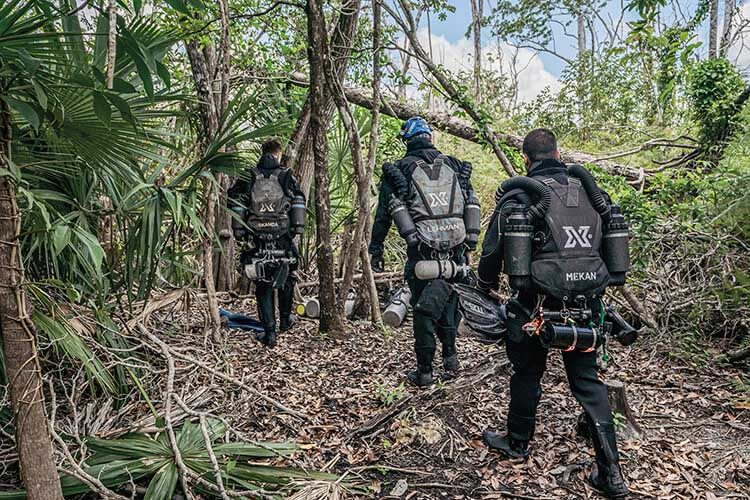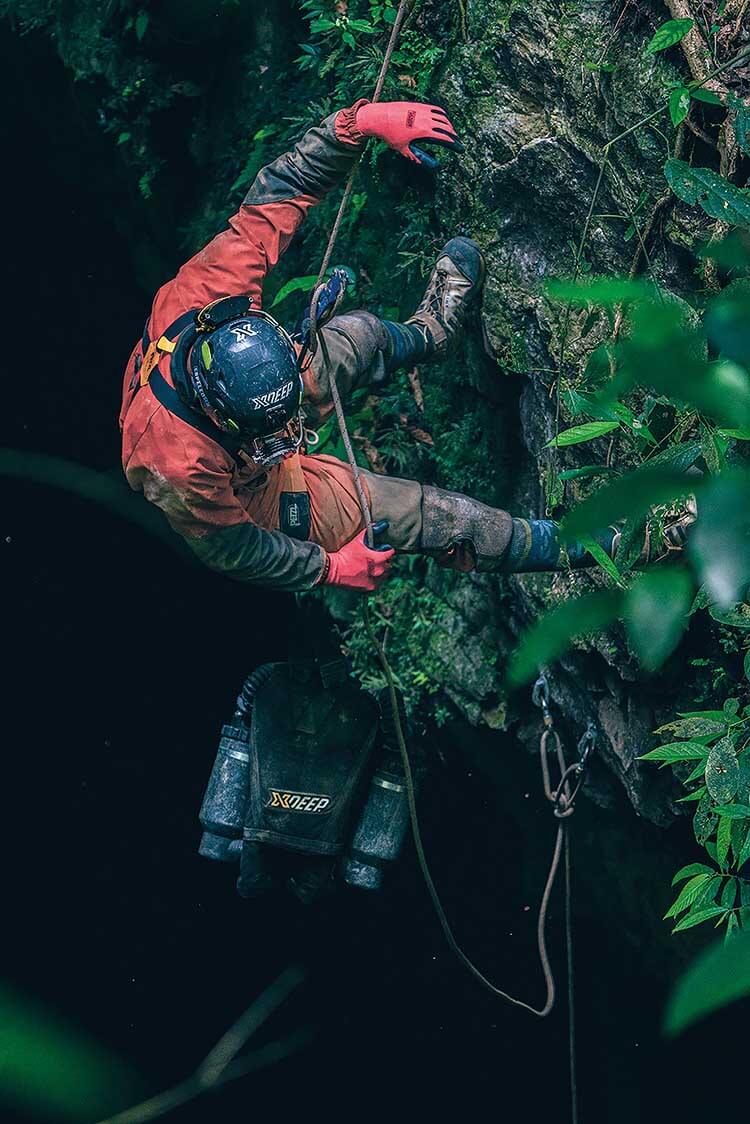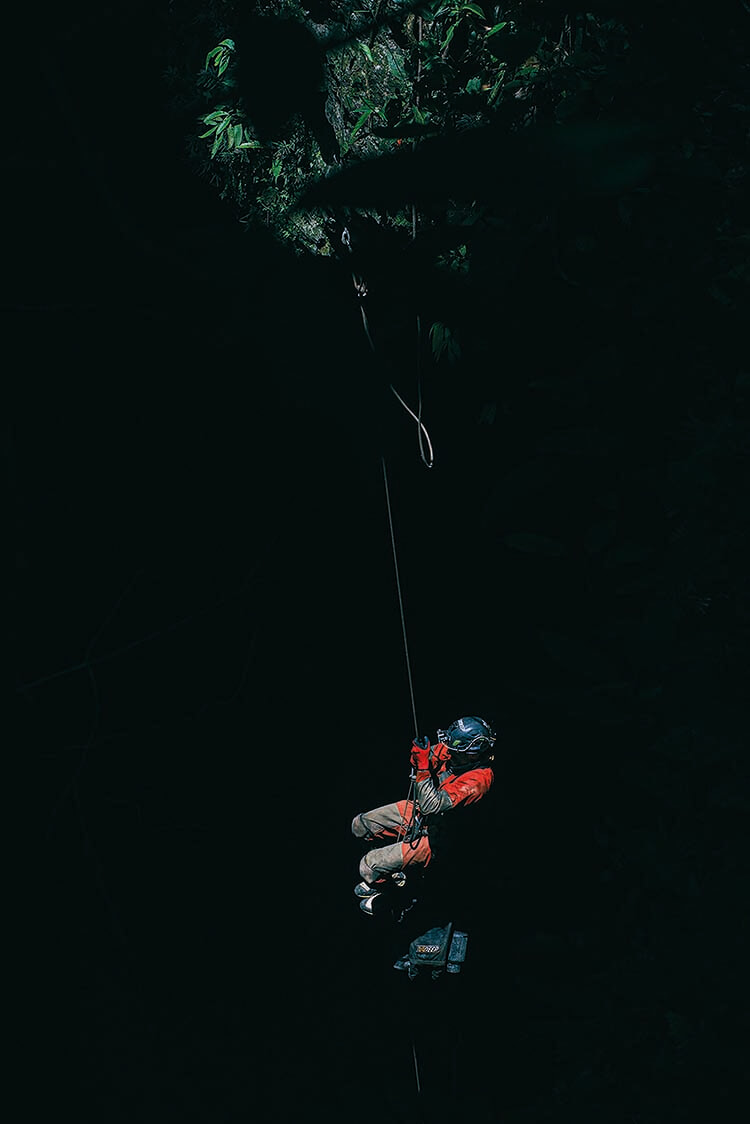
Alfred Minnaar spent four months in Mexico learning to cave dive and meeting some exceptional divers along the way. Here is his story of an experience that took him to his limits and beyond
Words and photographs by Alfred Minnaar
My philosophy on taking photographs is that you can’t fake it; everything must be authentic. Determined people who push themselves to the limit make for great images and compelling stories. To find such stories you must search out the special people who put themselves in difficult environments and face tough challenges. And sometimes, you must push yourself to become a better diver, a better photographer, just for them to consider allowing you to join them for even a small part of the adventure.
That’s what happened when I headed to Yucatán in Mexico for four months that would change my life. One of the first of the many extraordinary people I met during this trip was the renowned cave diver Patrick Widmann. Famous for exploring cave systems in Brazil and Madagascar, he runs ProTec Dive out of Playa del Carmen and Tulum with his business partner, Kim Davidsson.

For the next four months, I would follow their team around while trying to become a qualified and proficient cave diver myself – a challenge that tested me mentally and physically as nothing had ever done before!
Based at ProTec Tulum for my stay, I met up with my old friend Álvero ‘Mekan’ Herrero, now the resident photographer at ProTec. Mekan, who is from Madrid, worked with me in Indonesia as a dive photographer. He introduced me to one of ProTec’s instructors, Skanda Coffield, a former high school teacher from Melbourne, who is now a cave instructor with what Mekan describes as a ‘mild obsession’ for exploration.
Skanda told me they had a trip into the jungle starting in the next few days, if I wanted to come along. I was not a cave diver at that stage, but I did not want to pass up the opportunity to see what these guys got up to. So, I decided to tag along. The next day, we met early in the morning. The guys ran through their checks, everyone was diving rebreathers, and we started loading the truck.
It became apparent that even though Skanda is a great and dedicated teacher, his real passion is exploring and documenting caves. Mekan was part of the team, along with Phil Lehman, also closely involved with ProTec. We drove into the forest on some dirt roads and get to a place called Kim Ha. Skanda told me it had been a Mayan ochre mine before it had been flooded hundreds of years ago.


The location was nothing special: a short walk from the road we found a small brown pond that could have been mistaken for a puddle. It was hard to believe that this leads to a magnificent cave system. It made me wonder what mad person first stuck their head down there. It must have been an individual with an unusual outlook on life. However, as I go on to discover, that’s just the average cave diver.
When we arrived at the puddle, Skanda first made a small fire piling leaves around it to create plenty of smoke. It’s to help with the mosquitoes, he told me, while smiling. His words would haunt me later. After calling Indonesia home for the past few years, I thought I knew mosquitos, but I quickly realised I had a lot more to learn. While taking photos, I was bitten so severely that I had swollen hands for a week. Next time, gloves!
This clearly was not Phil’s first rodeo, as he was covered from head to toe in protective clothes. He was the main reason we are here. Phil is a testament to what a diverse group of people you find in the world of diving. He was a highly successful graffiti art pioneer of France in the 1980s, known as Bando. Now he sponsors cave exploration. He has discovered the most extensive cave systems in Africa and Madagascar with Patrick.
He tells me he thinks people who go into the jungle for fun must be crazy. The only reason, he insists, on being here is to get underground. If it weren’t for the caves, he would never set foot in a jungle. Phil was going to film the day, and Mekan would help document with photos of what happened underwater. Mekan is an exceptional photographer and someone who would help take my cave photography to the next level over the following months.
Watching them jump into the puddle and disappear into the depths, I desperately wished I was joining them. But that wouldn’t be until I was cave-qualified.


The next trip I took with the team was to a recently discovered cenote called Plasma Torus. This one was harder to get to and involved a drive into the jungle and then a 40-minute hike using porters to help carry the tanks. The entrance to the cave was tucked under a tree. We were joined by the other co-owner of ProTec, Kim, who is from Sweden, but moved to Mexico more than 20 years ago, and is a veteran of cenote exploration. On this dive, they laid three reels’ worth of new line into a previously unexplored cave system. That would be my last time out with the team for a while because I was about to start my cave diving course.
My instructor Elliot Smith, an experienced cave diver from Bromley in England booked a ‘fun’ dive with ProTec and was so impressed with their method of diving he instantly booked himself onto an entire retraining course. It can take more than two years to get up to the standard needed to be a ProTec instructor. Elliot’s passion lies with teaching and while he enjoys cave exploration, he prefers sharing and passing on his extensive skills to others. Think of him as an army drill sergeant. His job is not to be your friend, but to prepare you for the coming ‘war’ ahead.
A cave diving course is tough, and it needs to be. It is one of the hardest things I have done and the most demanding course of my diving career. Unlike open-water training, where there is a generally accepted attitude that we pass students and then they get a bit more experience, in cave diving, they only pass you if they are one hundred per cent sure you are not a liability to yourself or your buddy in a cave. A lot of emphasis is put on buoyancy and proper finning techniques. For much of the course, you are blindfolded to simulate zero-visibility situations, and you learn how to find your way out and to handle different scenarios.


The course can take anywhere from nine days to two weeks, depending on a person’s capabilities. It can be broken up into three sections – cavern course, intro to cave diving and full cave diving – and does not have to be done all at once. The course is there to instil a belief in one’s own ability. It did just that for me: after passing it, I felt extremely comfortable diving caves. The situations they put you in during training are the most unlikely and extreme you might ever encounter, while most of the cave diving I did afterwards was relaxed and an exceptionally beautiful experience.
There is no denying that accidents do happen in cave diving, but most times, they involve people seeking out the extremes and pushing to the limits. For ‘regular’ cave diving, if you have undergone the appropriate training, you would be unlikely to find yourself in a dangerous situation. The caving community is very open to sharing knowledge and experiences. You will find people who had close calls blogging about it, and the community encourages learning from each other.

The course was one of the best experiences I’ve had. A big part of it for me was that it helped me become a better underwater photographer and it also allowed me to experience a little of what these exceptional divers achieve. I dived in the cenotes without my camera for almost a month after I had completed the course. I wanted to get to know some of the caves better, and I also wanted to be confident that I could take photographs while simultaneously hovering in the smallest of passages.
Light is everything in underwater photography and especially in cave photography, where it is entirely artificial. Mekan shared a lot of his knowledge and helped me in learning the art of cave photography. He is a man committed to his craft. He would let me sit in on his photography courses and taught me a lot about light; How he set up backlight to get the desired effect, the secrets of lighting divers from above without assistance and overall incredible tips. I can highly recommend his cave photography courses.



We would spend the days navigating and diving some of the beautiful cave system, with him sharing with me some of his favourite spots and taking turns helping each other out with pictures. One of the many special things about the Mexican cenotes is that you do not need to go deep into the caves to see something beautiful.
Tamara, one of the ProTec instructors, and Skanda took me to one of their favourite caves called Xulo. You go into the cave through a small pool of water and then an even smaller entrance that leads to the cave system below. As you enter the cave, it opens up into something spectacular. Beautiful and delicate rock formations are revealed by your torch beams. From the beginning to the end of the dive it gets more and more impressive. I would go back multiple times to Xulo.
We were fortunate to be there when the dry season ended and the rains had come flooding down. As the rain seeps through the jungle floor it soaks up the colours of the decomposing leaves, and in the cenote it creates layers of bright yellows or reds known as tannic water.
On another trip I got to see Skanda and fellow ProTec instructor Jake Bulman dive the Blue Abyss. The dive plan was to resurvey the existing lines and try to explore some new cave. It was a massive dive that took them down to 112m with a dive time of seven hours, five of those being decompression stops. They were running 60-minute bottom times at 100m. I’m proud and honest enough to say I was there only for the very start of such a massive dive.


I would follow the guys around a few more times, documenting their adventures. One trip stands out which pushed me to the edge of my abilities and proved to be my biggest challenge as a photographer. Patrick suggested that with Mekan I should accompany him on a week-long dry cave mission in the hope that we find some caves to dive. We jumped at the chance.
Patrick is driven by a need to search out the unknown. If he is not exploring, he is teaching cave diving all around the world. He started his career in diving at the age of nineteen and has been doing it consistently for the past twenty years. Exploring with Patrick is an intense experience. You wake up in the morning, pumping with adrenaline, and you go to sleep that night with the adrenaline still pumping. You are so high from it, and the feeling becomes so normal, that you don’t even realise it any more and it was only afterwards that I could put this into perspective.

After setting up a base camp, we explored the area looking for possible cave entrances. In the first few days Patrick would take us to the edge of cave entrances looking for ones which might lead to the depths. He would toss a rock into the entrance and see how long it took to hit the bottom. Eventually he found one where it took eight seconds before the crashing bouncing, racket stopped. We would then rope up and start to descened into the abyss.
That set the tone for the week. Patrick never looked back and Mekan and I would follow behind. We spent at least six hours a day underground, navigating passages and spending large parts of the time keeping our ropes away from razor-sharp rocks. The sites were spectacular, with huge caverns followed by even more awesome caverns.
The full extent of the trip did not really set in for me until weeks later, and even now, as I am writing this article, I am still in a daze. Four months in Mexico diving caves taught me one thing: there is much still to learn. But the lessons I did learn will be a good start to the journeys ahead.





A special thanks to everyone from ProTec taking time to share it with me and for introducing me to a small part of their lives. Also, thanks to all the cave divers I met out there. You are a special breed. Until next time!
To learn more about cave diving and courses available go to protecdivecenters.com. Check out Instagram accounts @protecdivecenters and @mekanphotography
More great reads from the cenotes

- Going Beyond: Alfred Minnaar learns to cave dive - 27 October 2022
- Ice cool scuba diving in Lake Baikal - 8 September 2022
- A pirate’s life: the story of Raja Ampat’s Calico Jack - 16 June 2022


